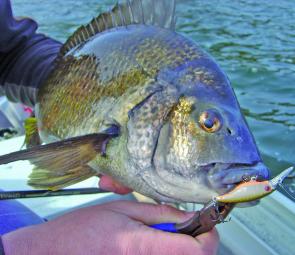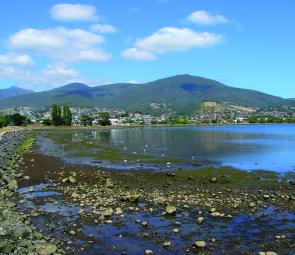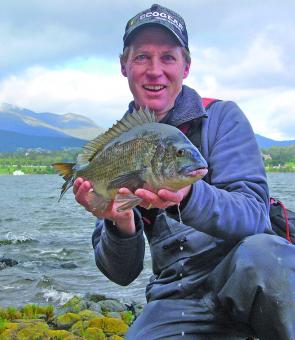February on the Derwent River heralds the start of some fantastic flats style fishing for our big Tasmanian black bream.
The bream have returned to their regular duties of fossicking for food until they find a good patch of tucker. These food rich areas are often open expanses of shallow flats and reef.
Bream lock into an aggressive and hard working state of mind to make the most of the abundant food on offer during the warmer months. This creates an extended boom period for lure anglers.
This style of feeding normally starts during January and runs right through to the end of April. The majority of bream settle into their preferred estuarine zone between Bridgewater and Sandy Bay at this time.
While bream are always on the lookout for a better or easier place to feed, this period is the best time of year to find fish operating on a regular beat.
While the Derwent flats are not really your traditional open sand and rubble type locations, which make Georges Bay at St Helens such a popular destination, the varying types of steadily sloping shores on the Derwent produce the same tidally influenced feeding patterns.
Packs of bream lay waiting in deeper water, depressions or gutters until water depths allow access to favoured feeding areas. Many spots on the river exhibit the terrain types that commonly harbour bait and hence attract the bream.
Here’s a break down of the main flats type areas on the Derwent.
There are several areas of combined weed beds mixed with silt and gravel bottom around Green Point (Bridgewater), Austins Ferry (Boat ramp to Whitestone Point), Old Beach, Prince of Wales Bay (shallow backs of bays), Elwick Bay (Montrose) and Cornelian Bay (northern shore).
Here amongst the weed there is an abundance of shrimp and baitfish that keep the bream very occupied. Light jig head rigged plastics and slim shallow running minnow hardbodied lures work best.
At high water, lures can be worked into the shallow weed edge and against any timber snags that you might find. Rolling lures through the gravel patches or between weed clumps is a good method as well.
Gutters, outer weed bank edges and any deeper depressions are all work a look on the run out or at low water periods. Methodical slow scanning with polarised sunglasses can help to locate shallow cruising bream in these parts of the river.
It’s no secret that gently sloping or undulating flats with rocky outcrops are a major drawcard for the local bream. These locations often have a rubble and silt periphery mixed with sloping rock bars and or ledges. The southern shore of Dogshear/Cadbury Point, northern shore of Dowsing Point, Risdon Cove, northern entrances of Prince of Wales, Newtown and Kangaroo bays, Lindisfarne Point and Rose Bay all have a mix of rock flats type attributes.
As always, bream are structure orientated fish and they will gravitate to the best ambush type holds in any particular area when not actively on the hunt.
In these areas it can pay to be aware of the best ledges and boulder gardens, as bream will often lurk amongst cover away from the flow. When the dinner bell rings, bream will break away from their lairs and happily feed over the shallow rock bar shoulders and onto the open rubble areas.
Look for panicked baitfish or the tell tale bronze flashes from bream as they tilt to snatch a crab in the shallows. While shallow running hardbodied lures are the norm, there is often the need to use a deeper running version to probe the outer margins and drop offs.
While the inshore fringes may be less than a metre deep, the outer zones can range from 1-3m+ will hold plenty of bream at times.
Mid river type settings can also be great bream fishing locations.
Several areas of open weeded flats exist between Granton and Bridgewater, north of Cadbury Point near the channel marker and across the stretch of water between Bilton and Beedhams bays.
The channel markers are in fact a good way to locate the edge of these mid depth weed beds. Although fishing over this type of ground can be challenging with so much lure fouling weed about, these spots can turn it on during the tide changes.
Start by working any nearby markers or weed bed edges and then fish over the weeds once bream are located.
There are several locations where wide open deep flats are punctuated with a rocky crown of reef throughout Elwick Bay.
The eye can see these areas when a slow to steady current occurs during calmer conditions. The up-welling and pressure waves make the otherwise unseen structures more obvious at these times. Positioning your boat down current and casting up current and over any structure visible on the sounder can pull some great bream when schools are present or conditions allow you to fish.
Small jerkbait style hard lures are the best choice here, but be prepared for some lure loses and dramatic battles as this is as nasty as breaming gets on the Derwent.
Being on the water and ready to fish prior to high tide is very important when preparing to fish spots that only hold a foot or two of water.
Planning your trip at just the right time will make a big difference if you need to fish these locations. Otherwise there is always the prospect of working any nearby depth change zone. Certain locations seem to have a gently sloping gradient and cover for the bream at most stages of the tide and are not too dependent on water level.
Other areas have a deeper fallback hole that can hold the bream during low tide. When searching for flats bream, try to keep these variables in mind and continue testing different depths with lures that operate near or just off the bottom.
A good quality sounder is a very important searching tool in this as with most breaming situations, as it can help to find hidden but likely holding areas. For shore based anglers, pulling on the waders and spending some time walking the shore at low water is another great way to discover holding zones over new ground.
If I had to select a best all-round time to hunt about the flats, it would be during a rising tide early in the day combined with a decent cloud cover to keep the light levels down.
Wind can also play an important role in improving the potential of a day. Dead calm days can be tough and always require a more stealthy approach, especially when boating.
However, a steady breeze can help to disguise the presence of both shore-based anglers and boaters alike.
The next part of the equation is choosing the right lure and set-up to chase these wonderful bream, which will be covered in part two in next months issue.
Reads: 8360
The Ecogear SX40 is a top lure for the flats feeding bream.

A classic Derwent rock garden exposed at low tide, a great location for bream to ambush baitfish amongst the boulders when high tide approaches.


Some typically fat Derwent bream come from shores like this one.

The author with a shore-caught bream. Note the wind pushing in on the shore, which helps stir the bream up.

Gavin Dunne with a fat bream taken from a shallow mid-river reef.

This bream was hooked in only a foot or so of water on an Ecogear MX48f.

Soft plastics can work pretty well too – this one was taken on a Slider worm.

Here Toby Broomhall deals with the initial runs of a solid bream at Cornelian Bay.

Nigel Harris nets a solid fish up from Austins Ferry.

Bays such as this on the eastern shore of the Derwent hold many shallow water feeding fish. An onshore wind helps a lot to fish this bay effectively.




